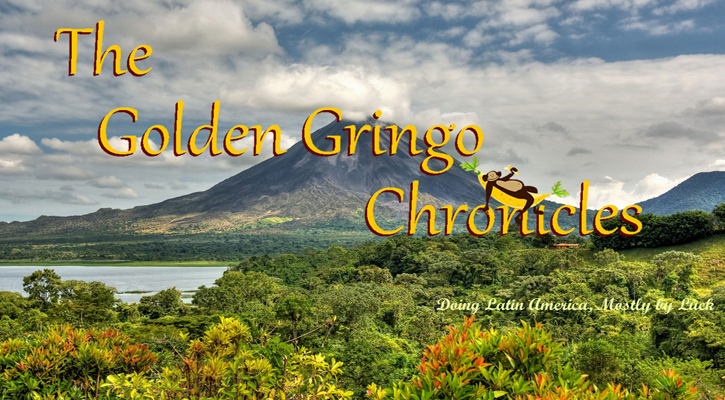

Edition 114 - February 2018
Published at Quepos, Province of Puntarenas, Costa Rica
Publisher: GGC Publications Group
Editor: Bob Normand, The Golden Gringo, aka "GG"
(©Copyright 2008-2018 All Rights Reserved)
"The mission and goal of the Golden Gringo Chronicles is to provide,in an informative and entertaining way, insight into living the Costa Rican experience as an expat."
1. Broken News: Futbol News; Zapote Bullfight Stats; It's SJO not SJC; Level 1 Safety for Costa Rica; Las Pints
2. Rumble and Weather Talk: Quake and volcano activity all across the Rim but no serious damage or injuries reported.
3. Feature: Golden Gringo University: Understanding Costa Rican Culture (Part I: History, Physical Size and Population, Constitution, Government Structure, The Economy)
4. ¿Que Es Eso? Department: What's Different About This Beach?
5. Feature: A Bout With Bureaucracy (and a Lesson in Gratitude)
6. Health Stuff: Obesity, Costa Rica vs U.S.
7. What's-in-a-Word: Answer to Que Es Eso, Las Pints, Contraloria
8. ROMEO Corner: Ronny's Place (Mi Lugar), Manuel Antonio
Wisdom of the Ages
|
Futbol News

 New Futbol Section. If you live in Costa Rica the thing shown to the left is a futbol (not a football) Actually, in Spanish it's called a "pelota" and is often confused by Gringos with a game called "soccer". In Costa Rica, futbol is played almost exclusively and it's also played in, maybe, another 100 or so countries around the globe. The thing shown to the right is often played in the upper part of North America and much less frequently in other countries. But to each his (or her) own.
New Futbol Section. If you live in Costa Rica the thing shown to the left is a futbol (not a football) Actually, in Spanish it's called a "pelota" and is often confused by Gringos with a game called "soccer". In Costa Rica, futbol is played almost exclusively and it's also played in, maybe, another 100 or so countries around the globe. The thing shown to the right is often played in the upper part of North America and much less frequently in other countries. But to each his (or her) own.
With the upcoming FIFA World Cup Futbol games in Russia in June and July next year, to which Costa Rica has earned a berth, futbol-speak is increasing daily here. GG thought it might be useful to create a separate section of Broken News just for Futbol News. Et voila, here you have it, Futbol News.
 |
| The Dude |
Keylor Navas Voted MVP of CONCACAF. Costa Rica's most famous football player to date without a doubt is Keylor Navas. He was the hero of the national football team that made it to the quarter finals in the 2014 world cup and will again be goalie for Costa Rica in the 2018 games. Since his outstanding performance in the 2014 series he's been a winning goalkeeper, or portero, for Real Madrid (pronounced ray-ahl mahdrid). He's been in the goalie position while Real Madrid won 10 titles since 2014 including the Spanish League, the Champions League and the European Super Cup.
This latest reward and recognition to Navas is particularly impressive because the votes are cast by captains of various national teams and team trainers as well as fans. His performance at Real Madrid has garnered him a reported $1 million plus per year salary. That's a lot of colones (about 570 million actually) but, methinks, Señor Navas is about to get another raise, if he hasn't already. And what about those endorsements?
 |
| Oscar Ramirez |
Correction to January Futbol News. In the January edition of Futbol News the following was mentioned about the World Cup games in Russia this year: "The Sele will once again be coached by Jorge Luis Pinto, a gentleman from Colombia" as it was in 2014. One of our avid Chronicle futbol fans read this and promptly emailed GG saying I had it wrong, that Pinto had been succeeded in 2015 by Oscar Ramirez, a Costa Rican (photo right). We confirmed that indeed Ramirez is now the coach.
 |
| Mea Culpa |
We have to admit this was bad reporting on the GGC's part. Of course, whenever that happens GG, as managing editor, always blames it on a lower level, unnamed editorial staff member.
Come on amigos, if all those reporters out there can have unnamed and unverifiable but "reliable" sources then GG ought to be able to have an unnamed, unreliable editorial staff member to blame when bad things happen.
Yeah, baby.
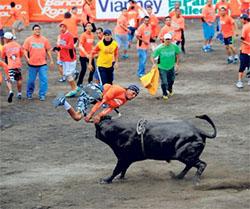 |
| Zapote Bullfight - Ouch! |
In the Zapote barrio of San José a festival happens on the last week of the year which includes parades, mucho Christmas decorations etc. It also features bullfighting Costa Rican style. The law forbids direct injury to the bull by way of swords or picadors like in the old days or like found in the classic performances in Spain. The chance of the bull dying or receiving serious injury here is very low, much lower than the same chance for the bull "fighters".
The bullfighters, basically large numbers of ordinary people, many well lubricated with guaro (cane liquor) or other libations, are allowed to get into the ring with the bull and taunt the hell out of it. They don't kill it, they just work the beast into a state of frustration and confusion until it probably wishes it were dead.
The statistics are now in for the 2017 Zapote Festival : 418 people treated for various problems (352 injuries and 66 "other" problems). Fortunately, the Red Cross has a sizable contingent at the festival to treat the injured on sight and only 54 of those required transfer to a medical center. And here's an interesting statistic: 316 of the injured, or 75%, were women with a majority of those being in the 21 to 30 age group.
Whoa amigos (and amigas), is this now the Costa Rican version of women's lib?
For a look at a Quepos bullfight GG had written about in the past, go HERE.
It's SJO not SJC
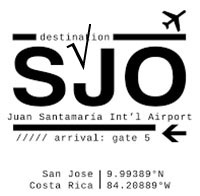
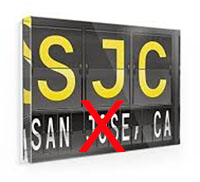 A recent press report stated that a family who lives in California but traveling through Europe ended up in the wrong country on their way home.
A recent press report stated that a family who lives in California but traveling through Europe ended up in the wrong country on their way home.
Flying Lufthansa on their return, they somehow got booked into San José, Costa Rica (call letters SJO) instead of San Jose, California (call letters SJC). Because the call letters are so close this kind of mistake is not as unusual an occurrence as you might think).
Watch your tickets and baggage tags amigos, it can make a difference.
GG hopes that our unplanned visitors had a good time while in Ticoland.
Level 1 Safety for Costa Rica
The U. S. State Department has come up with a new advisory rating system for nationals planning to visit foreign countries. There have established four security ratings and they go like this:
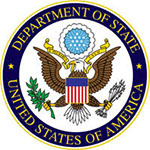 Level 1: Exercise Normal Precautions: Lowest-advisory level for safety/security risk.
Level 1: Exercise Normal Precautions: Lowest-advisory level for safety/security risk.
Level 2: Exercise Increased Caution: Be aware-heightened risks to safety/security.
Level 3: Reconsider Travel: Avoid because of serious risk to safety and security.
Level 4. Do Not Travel: Highest risk level. Greater likelihood of life-threating risks.
Costa Rica is rated Level 1. Other countries like Mexico and Nicaragua are ranked in Level 2, while El Salvador and Honduras are in Level 3. Countries grouped in Level 4 include: Afghanistan, Iran, Iraq, Libya, Syria, South Sudan, and others.
The system also gives localized advisories within countries when appropriate like, for example, staying away from a volcanic area when it's active (volcanoes Poas/Turrialba were getting active again when this was written). See a complete list of country advisories go here: U. S. State Department Travel Advisories.
Concurrently, an organization called In Sight Crime published a summary of murder rates (homicides per 100,000 population) for 2017 for Central American countries: El Salvador (60), Honduras (40.8), Guatemala (26.1), Costa Rica (12.1), Panama (10.2), Nicaragua (7). Just for comparison: U.S. (5.3), Baltimore (55.3), Detroit (40.0), Chicago (24.1).
Las Pints
There is an old saying in Costa Rica, along the lines of a myth, legend, superstition or old wives tale. The legend is that the first twelve days of the year portend what the weather will be in the coming months. That period, January 1-12 is called las pints According to las pints, rain on January 1 means January will be a rainy month whilst dry and hot on January 5 means May will be hot and dry etc. If las pints is correct this year both February and May will be rainy because January 2 and 5 were so. We'll see amigos, certainly January turned out to be rainier than normal.
 Some say las pints is the Costa Rican version of the Old Farmer's Almanac, which is still published in the United States. The Almanac is, however, based on certain observations that may relate to science such as sunspots and physical changes in flora and fauna at certain times of the year. The Almanac makes it's long range forecasts 18 months in advance and claims an 80% accuracy. GG is not sure if anyone has studies that show how accurate the forecasts from las pints are.
Some say las pints is the Costa Rican version of the Old Farmer's Almanac, which is still published in the United States. The Almanac is, however, based on certain observations that may relate to science such as sunspots and physical changes in flora and fauna at certain times of the year. The Almanac makes it's long range forecasts 18 months in advance and claims an 80% accuracy. GG is not sure if anyone has studies that show how accurate the forecasts from las pints are.
Meteorologists tend to downplay the legend strongly as an old wives tale but will also readily admit that their own long range forecasts, i.e. beyond three months, are not so good either.
(An attempt to explain the etymology of the term las pints is in the What's-in-the-Word section below)
¡Pura Vida!
 GGC Publications Group is the parent organization that publishes the Golden Gringo Chronicles as well as a number of books and paraphernalia related to the Chronicles and Costa Rica.
GGC Publications Group is the parent organization that publishes the Golden Gringo Chronicles as well as a number of books and paraphernalia related to the Chronicles and Costa Rica. The page is called GGC Publications Page - Products and has 3 sections:

 This section of the GGC Publications Page consists of descriptions of the following books published by GGC Publications:
This section of the GGC Publications Page consists of descriptions of the following books published by GGC Publications:Or go here for all of them: GGC Publications Page - Products Section I
Section II: Recommended Inspirational Books - Life Changing Stories

 S.O.B.E.R. - How the Acronyms of AA Got One Drunk Sober - by Ian Asotte (description and details HERE)
S.O.B.E.R. - How the Acronyms of AA Got One Drunk Sober - by Ian Asotte (description and details HERE)
◄To Eternal Happiness - by Abelardo Garcia, Jr. (see description and details HERE)
A Woman Awakens: Life, AfterLife - by Jan Hart (see description HERE)►
Or go here to see all of them: GGC Publications Page - Products Section II
Section III: T-Shirts and Coffee Mugs All About Costa Rica and the Chronicles
In addition, GGC Publications Group now also offers t-shirts and coffee mugs that are related to the Golden Gringo Chronicles with Costa Rican themes, to wit:

 T-Shirts: a. Golden Gringo Chronicles with Logo, b. Official Golden Gringo with Monkey on Banana Hammock, c. ¡Quepo en Quepos! ("I Fit In Quepos!") with Photo of Quepos, d. Wanna Monkey Around - Come on Down! with Photo of White Face Monkey and e. It's OK to be Slothful with photo of Three-Toed Sloth.
T-Shirts: a. Golden Gringo Chronicles with Logo, b. Official Golden Gringo with Monkey on Banana Hammock, c. ¡Quepo en Quepos! ("I Fit In Quepos!") with Photo of Quepos, d. Wanna Monkey Around - Come on Down! with Photo of White Face Monkey and e. It's OK to be Slothful with photo of Three-Toed Sloth.
Coffee Mugs: a. Golden Gringo, b. Wanna Monkey Around?, c. OK to be Slothful
Pacific Rim is Active
The Rim was active in January recording a few earthquakes and resumption of emission activity in a couple of volcanoes along the Cordillera, the Spanish name for a central mountain spine, of which Costa Rica has one. None of these occurrences caused significant damage or injuries.
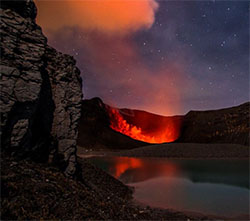 One earthquake registered 6.1 Richter and was epicentered about 40 miles off the west coast of northern Costa Rica not far from the border with Nicaragua. Another one, 4.8, occurred a few kilometers off the shore southeast of Jacó while yet another of similar size was centered just east of Liberia.
One earthquake registered 6.1 Richter and was epicentered about 40 miles off the west coast of northern Costa Rica not far from the border with Nicaragua. Another one, 4.8, occurred a few kilometers off the shore southeast of Jacó while yet another of similar size was centered just east of Liberia.
On the volcano front, our old friend Turrialba, east of San José, started throwing out plumes of ash again and exhibited some very colorful lava boiling. If you recall, this funnel was quite active last year and actually shut down the main San José airport a couple of times for a few hours each. In fact, Turrialba has remained active almost on a constant basis for the last three years.
The University Seismology "Red" (network) got out one of their new drones and captured some great shots including the spectacular bloom shown at the right. How pretty can a night scene get?
Check Out Recent Earthquakes Around the World Posted by the U.S. Geodetic Survey: Recent Quakes |
Search the Golden Gringo Chronicles Archives for Topics That Interest You
You can use our Archives to search for anything that has been written in more than 220 feature articles of the Golden Gringo Chronicles plus find Broken News items and ROMEO restaurant reviews. Enter your topic or item to search in the Google Search Routine below and follow the links offered from the search results. Suggestion: Enter only a simple, precise and unique as possible keyword or two in order to narrow the number of references retrieved:
Readers: Our publication is open to suggestions regarding future articles and will accept pieces written by others but we reserve the right to decline anything that the editorial staff (that's GG) thinks is inappropriate for this format. Send proposals, comments, suggestions, ideas, meaningless statements and jocular observations concerning the Chronicles to GG here: gg@goldengringo.com.
 The idea behind Golden Gringo University is to present educational topics of wide interest to expats who have recently moved to Costa Rica, or to future expats who might be thinking of moving here or to those who simply visit here frequently. Our goal and objective is to provide accurate information that readers will find helpful in their efforts to be a good expat resident or visitor in Costa Rica. Golden Gringo University was inaugurated in November 2017 and its first article can be read here: Getting Residency in Costa Rica - an Update.
The idea behind Golden Gringo University is to present educational topics of wide interest to expats who have recently moved to Costa Rica, or to future expats who might be thinking of moving here or to those who simply visit here frequently. Our goal and objective is to provide accurate information that readers will find helpful in their efforts to be a good expat resident or visitor in Costa Rica. Golden Gringo University was inaugurated in November 2017 and its first article can be read here: Getting Residency in Costa Rica - an Update.
In this month's issue we offer the first installment of a three part series about understanding Costa Rican culture. In this edition, Part I, we discuss the basic societal structure of Costa Rican including the country's history, its physical size and population, the Costa Rican constitution, the government structure and stability and the economy.
History of Costa Rica
Costa Rican history basically divides into three periods; 1) Pre-Columbian, i.e., before Columbus and the Spanish arrived in the late 1400's and early 1500's, 2) the 300 year Spanish period that started around 1502 and ended in 1821 with Latin America's declaration of independence from Spain and 3) the modern period, which is now about 200 years old.
To get a good summary of these three periods and their effect on Costa Rican history and culture it is strongly suggested that you read and consider the following articles before going on:
History of Costa Rica: Edition 61 - CR History - Pre-Columbian
History of Costa Rica: Edition 62 - CR History - The Spanish Period
History of Costa Rica: Edition 63 - CR History - The Modern Era
Costa Rica is a small country in territory, ranking #130 in physical size of all countries around the globe. The land area is 50,660 square miles (.05 million sq mi) as compared to Canada (9.06 million sq mi), the U.S. (9.17 million sq mi), China (9.60 million sq mi) and Russia (17 million sq mi) - lets not quibble that most of that Canadian and Russian territory is frozen. Costa Rica ranks fifth in size in the seven Central American countries (Guatemala, El Salvador, Honduras, Belize, Nicaragua, Costa Rica and Panama) being larger only than Belize and El Salvador and less than half the size of Panama and Nicaragua.
Costa Rica is also small in population, less than five million, ranking #124 in the world and #4 in Central America. It's interesting to note that, while the population in the U. S. grew 62% in the last 50 years, Costa Rica's growth was more like 276% having started from a 1.7 million base in 1967 and nearly tripling to 4.7 million currently.
Constitution
The Costa Rican Constitution, known as the Second Republic, was formed and approved in 1949 after a brutal civil war. The prevailing military junta at that time drafted the new constitution based on the First Republic constitution that was put together in 1871. The new constitution abolished the army, gave women the vote, made conservation of the country’s natural resources a law of the land, and handed the country back to democratically elected legislators (bravo, military dudes!).
The Costa Rican Constitution is a rather long, broad-ranging document (196 Articles with no numbered Sections and almost 19,000 words) as compared to the U.S. Constitution (7 Articles, a few numbered sections and about 4,500 words).
Here are some of the Costa Rican Constitution's key points and more interesting features:
It invokes the name of God in the Preamble and reiterates faith in Democracy.
Creates three branches of government; the Executive, the Legislative and the Judicial.
The Army as a permanent institution is proscribed (banned). Military forces may only be organized by a continental agreement (whatever that means - ed.) or for the national defense.
People can become citizens by having a Costa Rican parent, either here or overseas or by naturalization. Dual or multiple citizenship with other countries is accepted if that country accepts Costa Rican citizenship (U.S. and Canada no problem).
Right to life is protected (Article 21). "The human life is inviolable."
Right to privacy and secrecy in communication is guaranteed.
The rights of association, assembly and expression are guaranteed.
Costa Rican citizenship is "not lost and is not renounce-able".
There are 10+ articles that list rights similar to U.S. Bill of Rights (habeas corpus, self-incrimination, speedy trial etc.)
Several articles address the importance of protecting the environment.
The constitution defines the work week as six days followed by one day of rest plus paid annual vacation.
There is a right to join trade unions and to strike.
Roman Catholicism is defined as the state religion but freedom of other expressions is guaranteed as long as they are in conformance with other laws.
Spanish is the official language but the state is charged also with supporting indigenous languages.
Guarantees freedom of access to higher education and academic freedom.
A balanced budget article (#176) is included: "In no case may the amount of budgetary expenditures exceed that of probable revenues". (Yet the current budget is more than 20% in deficit - ed.???).
Oversight is vested in a Supreme Tribunal of Elections, a Controller General and an Ombudsman that operated independently from the Executive and Legislative branches.
All rights under the constitution, except the right to vote, are guaranteed to visitors with valid visas and to formally approved residents (like GG) as long as all laws and regulations are adhered to.
Further detail on the Costa Rican constitution, including marginal notes that identify its key aspects, can be found HERE.
Government Structure and Stability
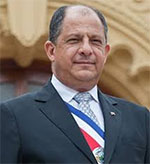 |
| Guillermo Luis Solis Rivera - President |
 |
| Helio Fallas Venegas 1st VP |
 |
| Ana Helena Chacón Echeverria - 2nd VP |
As described above, the current form of government in Costa Rica is a Constitutional Democratic Republic. Since 1949, regular, nationwide general elections have been carried out routinely and peaceably, one of the best records in Latin America.
The Executive consists of a President and two Vice-Presidents (not sure why double backup is needed or desirable but it's in the constitution and is part of every General Election). The President is head of state and head of government and elected every four years by popular vote. The next general election for the president, vice-presidents and the legislature, all at once, will take place on February 4, 2018 and the winners will take office in May.
Presidential candidates run on a ticket with their Vice Presidents under the same party banner. The Vice Presidents serve as backup and either VP may be called upon to act as president in the event of the President's absence or incapacitation. As mentioned above, the current President and Vice-Presidents (photos left) will turn over their positions in May of 2018 after general elections on February 4th.
General elections are held every four years. To win the presidency a candidate must garner at least 40% of the general election votes, not always an easy task as more than six popular parties and several others may also field candidates. In 2018 there are 13 candidates running. A runoff election is often necessary and the top two vote getters from the first election survice to run again in the run-off. Presidents and Vice Presidents may succeed themselves only after waiting out two consecutive terms (now that's real term limits, amigos! - ed.)
.
The Legislature is unicameral, i.e., consisting of one body called the Legislative Assembly and made up of 57 Diputados or members elected from various cantons (counties) and provinces, the number in each apportioned by population. Diputado candidates are elected by party members from the various parties of which there can and usually are several.
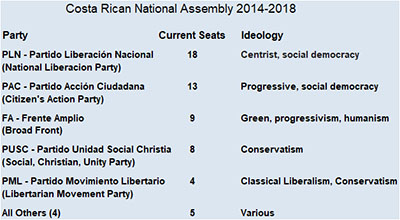 Political Parties beyond the more popular are often formed for a particular cause or objective and may go defunct before later elections.
Political Parties beyond the more popular are often formed for a particular cause or objective and may go defunct before later elections.
Currently the Assembly is made up of elected Diputados from nine different parties, the top five of which are shown on the table to the right. These five currently hold 52 of the 57 Assembly seats. There are currently some 13 parties that are fielding candidates in the 2018 General Election for President, Vice-President and Deputies.
Economy and Finance
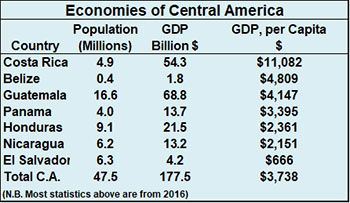 Costa Rica, as described above, is a small country but its economy has been growing steadily over the last fifty years. In more recent years it has posted good numbers in comparison with its Central American neighbors as shown on the table to the left, which is ranked by GDP per capita.
Costa Rica, as described above, is a small country but its economy has been growing steadily over the last fifty years. In more recent years it has posted good numbers in comparison with its Central American neighbors as shown on the table to the left, which is ranked by GDP per capita.
That table shows that Costa Rica, as measured by that standard, has a GDP Per Capita of $11,082 and is the most productive economy in the seven nation Central American region. It is more than twice that of its nearest C.A. competitor Belize and has a total value of GDP ($54.3B - 2016, 2017 est. $61.5B) that is almost 80% of Guatemala/s ($68.8B), the largest economy in the region, even though Guatemala has more than three times the population of Costa Rica. Here's another comparison, the GDP Per Capita of Costa Rica compares to its North American neighbors as follows: Mexico at $8,201, Canada at $42,158 and the U.S. at $51,467.
The major component break-down of the economy by GDP are: Services (hotels, restaurants, tourist services, banks, call centers and insurance) - 76%; Industry (electronic components, food processing, textiles and apparel, construction materials, cement, fertilizer) - 19% and Agriculture (bananas, pineapples, coffee, beef, sugarcane, rice, corn, dairy products, vegetables, timber, fruits and ornamental plants) - 6%. Despite its long and historical reputation as one of the more important exporters of pineapples, coffee and other agriculture products, this segment no longer dominates Costa Rica's economy. Currently total imports in all products, industrial and agricultural, exceed exports by some $3 billion per year.
On the international financial front, there is concern about the growing deficit situation. The government currently operates at a 20-25% budget deficit. Although the Costa Rican debt to GDP ratio (about 45%) is less than many developed countries (Spain - 97%, USA - 107%, Greece - 159%, Japan - 238%), the burgeoning public sector payments and poor tax collections have induced financial rating services to forecast a negative future if the current trend continues. Accordingly, they have lowered bond ratings to less than investment grade (BB- per S&P, vs Canada & US = AAA, Argentina = B+, Mexico = BBB+). Add to this the fact that unemployment continues to be high, persisting at over 8%, and it's very likely that the new president and legislature are going to face some tough decisions regarding expanding the tax base significantly while cutting public expenditures.
In next month's Part 2 we will discuss more personally-related cultural differences including language and education, money and banking, names and surnames, addresses and street signs.
¡Solo Bueno!
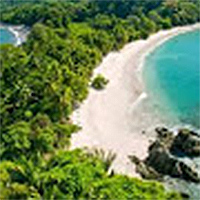
The photo is one of several beaches in Manuel Antonio.
What do you see about this beach that seems unusual? Look beyond the beauty of it all.
The answer is not that there are no people on it, although at this time of year that does indeed seem strange.
Answer in What's-in-a-Word section below.
¡Solo Bueno!
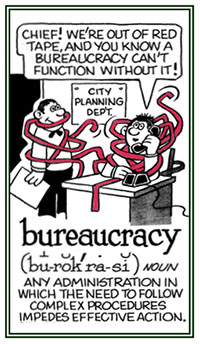 In a broad sense, GG has been quite satisfied with the national health care system in his adopted country (known here as the CAJA or cah-hah). I have come to recognize that there will always be the predictable bureaucratic irritations and hurdles associated with socialized medicine run by a government. Yet, I can also say that, once past the unnecessary complexities engineered by the "crats", the care given here by the doctors, nurses and other technical personnel has been technically competent, efficient and caring.
In a broad sense, GG has been quite satisfied with the national health care system in his adopted country (known here as the CAJA or cah-hah). I have come to recognize that there will always be the predictable bureaucratic irritations and hurdles associated with socialized medicine run by a government. Yet, I can also say that, once past the unnecessary complexities engineered by the "crats", the care given here by the doctors, nurses and other technical personnel has been technically competent, efficient and caring.
One of the things that becomes apparent in using this admittedly bureaucratic and overly structured system is that it does not deal well with extremes such as difficult heart problems on the one end and minor but necessary corrections on the other. Last year, even the head of cardiology at Hospital Mexico, the country's largest hospital, stated that as many as 200+ people had died prematurely waiting for heart operations due to a shortage of staff and equipment. Others report that equipment and technical capabilities are not up to the best prevailing practices for delicate procedures.
A couple of years ago, a gringo friend of mine, who had had bypass surgery some years before, went to a private and very reputable cardiologist in San José for a checkup. She gave him a good battery of tests and then announced that he probably would need another surgery. "I can have it done here, right doctor" says he. She responded: "You could, but you won't survive." Having gotten less than the most enthusiastic prognosis in his case, he returned to the U.S. for further treatment.
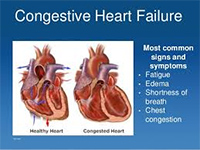 Congestive Heart Failure (CHF) falls into a more modest, middle category of seriousness. Left untreated, it is potentially fatal but treated well and early it is quite manageable. GG had an experience with CHF early in his residency here that was brought on by chronic bronchitis (read about that story HERE). I was treated and the medication regimen that I've been on since then, under two different doctors, has kept me in generally good health.
Congestive Heart Failure (CHF) falls into a more modest, middle category of seriousness. Left untreated, it is potentially fatal but treated well and early it is quite manageable. GG had an experience with CHF early in his residency here that was brought on by chronic bronchitis (read about that story HERE). I was treated and the medication regimen that I've been on since then, under two different doctors, has kept me in generally good health.
Three other occurrences in GG's Costa Rica experience so far has required me to use the CAJA, but these were less life-threatening than CHF. They involved 1) a bout with hypothyroidism which produces extreme tiredness and a lackadaisical attitude (even more than normal for a retiree) but which responded quite well to a simple iodine-based pill (Amiodarona), 2) a bout with serious back and knee pain that was worked out at the CAJA physiotherapy department after a few weeks of coached exercises and 3) cataracts, which GG developed about four years ago to the point of seriously affecting his sight , again something that made life difficult but not life-threatening.
 It is the CAJA experience with post-cataract treatment that prompted this article. I learned anew that things which may be serious but not life- threatening or those that need simple treatment for basic good health have a tendency to fall prey to the priorities of a bureaucracy or don't receive enough resources to get the job done in a reasonable amount of time. That's what this story is about, a personal experience with the bureaucracy when trying to get a simple procedure done. Bear with me while I set the stage:
It is the CAJA experience with post-cataract treatment that prompted this article. I learned anew that things which may be serious but not life- threatening or those that need simple treatment for basic good health have a tendency to fall prey to the priorities of a bureaucracy or don't receive enough resources to get the job done in a reasonable amount of time. That's what this story is about, a personal experience with the bureaucracy when trying to get a simple procedure done. Bear with me while I set the stage:
After being here something more than four years I noticed that my eyesight was getting worse. I had difficulties in focusing and reading signs in the distance (like when driving), accompanied by a certain haziness and yellow tinge about everything I could see. On a regular check-up visit to my CAJA doctor in Quepos, he examined me and diagnosed cataracts. Since they don't do cataract surgery in the Quepos CAJA, the doctor referred me to the Provincial CAJA hospital in Puntarenas (2-1/2 hours north by bus).
The first visit to the Puntarenas CAJA only produced an appointment for a couple of months later. Then on appointment day, September 5, 2012, fifteen minutes after arriving at the hospital, all operations there ceased when we were interrupted by the second strongest earthquake in Costa Rican history. The appointment was rescheduled for a couple of months later at a temporary location in Puntarenas as the hospital was totally shut down for repairs (it was later determined that the top 8 floors were unsuitable for renovation and they were razed). There is no doubt in my mind that the damage caused by the earthquake added to the already strained bureaucratic state of affairs at the Puntarenas CAJA.
 When the ophthalmologist finally got to examine me he concurred with my Quepos doctor; cataract surgery was needed. Unfortunately at the time, Puntarenas hospital didn't do cataract surgery either, so I got yet another referral to Hospital Mexico in San Jose (3 1/2 hours by bus). After a couple of visits there I obtained a surgery date and my left eye, was scheduled for operation and it was done on August 5, 2013 on my right eye. The post-op change in vision, focus, readability, crispness of edges and and ability to distinguish colors was dramatic. The second eye was scheduled and done on January 14, 2014.
When the ophthalmologist finally got to examine me he concurred with my Quepos doctor; cataract surgery was needed. Unfortunately at the time, Puntarenas hospital didn't do cataract surgery either, so I got yet another referral to Hospital Mexico in San Jose (3 1/2 hours by bus). After a couple of visits there I obtained a surgery date and my left eye, was scheduled for operation and it was done on August 5, 2013 on my right eye. The post-op change in vision, focus, readability, crispness of edges and and ability to distinguish colors was dramatic. The second eye was scheduled and done on January 14, 2014.
Three months after receiving my new right eye vision I was invited back along with a couple of dozen other ophthalmic post-ops (they do several dozen cataract and other eye surgeries there a week) for a check-up and adjustment. By that time, I had developed a slight fogginess in both eyes. The "adjustment" consisted of a technician or doctor, I'm not sure which, who sat me in front of a laser and went zrrrt, zrrrt zrrrt a few times with the laser in each eye. I'm not sure what the procedure is called but the whole process took about ten minutes and the result was that both eyes had perfect vision - yes!
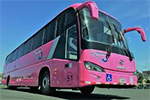 |
| Tracopa Bus to San José |
Fast forward to April 2016. Slowly over the two years after the adjustment, my left eye regained a significant degree of fogginess. Eventually I guessed another adjustment might be needed and mentioned it to my regular Quepos CAJA doctor and asked for a referral to Hospital Mexico. Done; the referral that is. A couple of days later when I arrived at HM I knew I would likely only get an appointment. Wrong, they looked at my referral and quickly said : "You have to go through Puntarenas first." And then they declined to examine me. I pleaded that the surgery and first adjustment had been done at HM and that Puntarenas doesn't do ophthalmic surgeries. "They do now" was the response and then they confirmed their rejection and for any further consideration. Back to Quepos. Grrr.
 |
| T.Q.P. Bus to Puntarenas |
That was a Friday and I rescheduled myself for a bus to Puntarenas on Tuesday, again knowing that I would probably not get to be examined and the day would likely result in just getting another appointment. I also suspected I would have a bit of difficulty with a referral paper that was made for Hospital Mexico CAJA and not Puntarenas and I would not be disappointed in that supposition. But even before we got to that discussion I ran into more stuff from the crats. When I arrived at the Puntarenas CAJA ophthalmology office I was told they don't do appointments or examinations on Tuesdays.
I know what all you private medicine gringos are thinking. Couldn't you just call and set up an appointment? Uh-unh, no, no, you have to sit in person in front of a scheduler with a computer terminal and prove who you are with your cédula and CAJA registration card. The scheduling room in Puntarenas is a madhouse with anywhere from 50 to a hundred people seeking appointments and pulling tickets to get a position in line and waiting for their number to be called by electronic device. My nickname for this room is the CAJA Sports Betting Parlor.
 I went home and came back on Wednesday with a Tico friend for support. Opthalmology shunted us to Sports Betting who, after me waiting 45 minutes for my ticket to be called, would not schedule an appointment - I guess because of the referral being for Hospital Mexico. I noticed next to the Sports Betting cubicles an office labeled "Contraloría" (See What's-in-a-Word section below for the definition of this word).
I went home and came back on Wednesday with a Tico friend for support. Opthalmology shunted us to Sports Betting who, after me waiting 45 minutes for my ticket to be called, would not schedule an appointment - I guess because of the referral being for Hospital Mexico. I noticed next to the Sports Betting cubicles an office labeled "Contraloría" (See What's-in-a-Word section below for the definition of this word).
I've come to understand a contraloría in almost any Costa Rican organization is the place where you try to resolve a problem or make a complaint so I suggested to my friend we go there. After waiting for a person to exit the controller of services office we spent 20 minutes with the lady and I got an appointment - only it was eight months away on December 26, 2017, the day after Christmas.
Sweet mother of pearl, would that that was the end of the story, but it isn't.
I show up at Puntarenas CAJA on December 26 with my appointment in hand which was written by name specifically for a lady ophthalmologist. There was no secretary at the desk again but a dude came from the back and said: “O, she’s not here today – vacation day!” Oh yeah, then I realized it was a Tuesday and, of course the day after Christmas which might be taken as vacation. But then how could you and why did you make an appointment for that day – naw, don’t even ask that question GG.
 Back across the street to get a new appointment (1 hour wait). I suggested to the appointment booker that I should be placed on top of the lady ophthalmologist's list for the first day she returns from vacation (my guess was Wednesday). “The system does not allow me to do that" said the bookie. She plucked at her computer for a while and then generated an appointment for August 31, 2021. Yup, I wrote that right amigos: 2021. This time there was no one in the contraloria office to go to for help (she was probably on vacation also).
Back across the street to get a new appointment (1 hour wait). I suggested to the appointment booker that I should be placed on top of the lady ophthalmologist's list for the first day she returns from vacation (my guess was Wednesday). “The system does not allow me to do that" said the bookie. She plucked at her computer for a while and then generated an appointment for August 31, 2021. Yup, I wrote that right amigos: 2021. This time there was no one in the contraloria office to go to for help (she was probably on vacation also).
I gave up and left, frustrated and angry but proud of myself for not going postal on the Puntarenas CAJA. The only thing I could think of was returning to Quepos and trying to enlist my local doctor and anyone else I could find to overturn this travesty. I’m still working on that and will let you know the result in a future edition.
I grabbed a quick sandwich and went to the bus stop to wait for the next bus to Quepos. As I approached the single bench available at the bus stop I noticed a man with a cane sitting there, the only space for me being next to him and that’s where I sat down. As I did, I also noticed some unusual things about him. He wore the kind of dark glasses that indicated he was either blind or impaired by strong light. He also had some extensive audio gear on both ears. Then I noticed the sign hanging around his neck and interpreted the Spanish as something like: “I don’t want money, but I may your help”.
 I was about to engage him in conversation when a young lady, who might have been his granddaughter, came up to him and whispered in his ear who she was and they should go. He smiled.
I was about to engage him in conversation when a young lady, who might have been his granddaughter, came up to him and whispered in his ear who she was and they should go. He smiled.
He got up and she helped him waddle across the street as he instinctively used his cane to feel out the road even though the young lady had him by the arm.
And that left Bob sitting there worrying about a minor vision problem in his left eye while the severely handicapped man limped slowly ahead and disappeared into the crowd.
And that was the lesson in gratitude for that day.
¡Pura Vida!
| Note: The information given in this section is offered as news information only and does not indicate GGC confirmation or denial of the accuracy of the treatment or a recommendation to pursue it, nor can we or do we guarantee the efficacy of the results nor validity of the conclusions proffered.
(How's that for a disclaimer?) |
Side Effects of Affluence?
Interesting, but rather negative health statistics are emerging these days about the physical fitness of the general population in Costa Rica. Take obesity for example.
The accepted international definition of obesity is a Body Mass Index of 30 or higher. BMI is calculated as the weight in kilos divided by the square of the height in meters; the formula is BMI = kg/m2. As an engineer I wonder why one would use a surface density measurement, i.e., per square meter rather than a linear measure such as per meter (sorry, GG got carried away with arithmetic again).
Here's an example of how BMI works using real numbers from an unidentified subject (guess who) as an example. If our subject weighs 240 pounds (109 kg) and is six feet (1.83 meters) his BMI is 109/(1.83x1.83) = 32.5 and he is over the obesity line. You can also use the formula to figure out what you need to lose. In our subject example, to come down to the obesity line he must lose 28 lbs or 13 kg. To hit the non-overweight line of 25 BMI, the subject would need to lose 61 lbs and would be at 180 lbs (GG hasn't seen that number since he was 31). But you don't have to figure it out; you can look up your BMI on the HHS chart below (in English units) and even interpolate where you want to be.
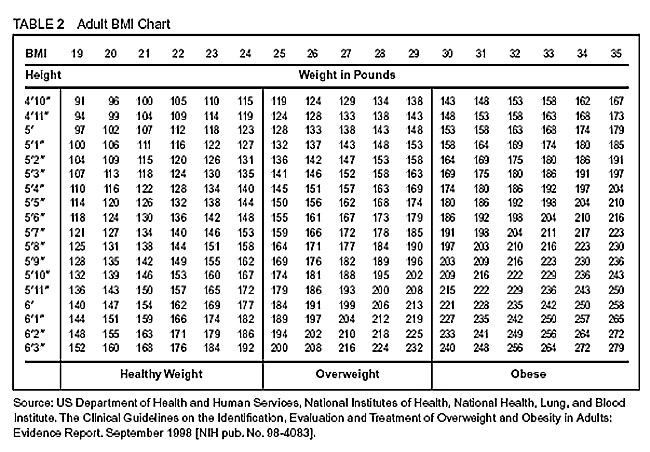
BMI is only a guide. Obviously some people at a given height can be narrow or wide-bodied and their comfortable BMI will be different (I like to think of myself as semi-wide bodied). Guys like Arnold Schwarzenegger or Vin Diesel would be considered wide and expected to have a higher healthy-level BMI accordingly. Most highly toned, muscle-bound dudes will also.
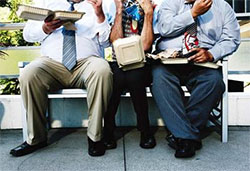 |
| Easy on the Pinto Amigos (Wonder What the Amigo in the Center is Eating?) |
Since 1975, roughly 40 years ago, the obesity rate in Costa Rica has nearly quadrupled from 6.3% of the population to 26.2%. Add to that people who are deemed (by sadists) to be overweight (defined as people with a BMI of 25-30) and you come up with a figure for Costa Rica that is nearly two-thirds of the population (64.2%). In the U.S. the figures for obesity hover around 37% and the sum with overweight brings it within range of the Costa Rican number.
Consider this: as little as 15 years ago, there was an 8" gap in height between the average Tico who was shorter and the average U.S. citizen. Reports are now surfacing that say that difference has been reduced to 2-3". My guess is the high-protein junk food, now available everywhere in Ticoland, is doing it. I can see it in the latest generation of Ticos and the kids that play at the Futbol arena on a daily basis. Many of the late-teen players are already over six feet. Like the height gap, the obesity gap is closing but, unfortunately, not in favor of the Ticos. So what is the cause of all this?
One doesn't need reams of reports from scientific studies to see that two things are contributing to an increase in obesity. Affluence is one of them. Costa Rica has been on a continuous path of growth in economic and personal wealth since the founding of the second republic in 1949. When people have more money, they eat more (not necessarily better) and they eat out more often.
A second factor is the change in the work environment. Like in the U.S. the work force has shifted from largely agrarian tasks which require physical effort to office work which is sedentary and, if you're like GG, not always made up for by outside exercise. What good exercise and a modest lifestyle can do for you was recently highlighted in the Chronicles regarding Costa Rica's Blue Zone in the Nicoya Peninsula where they have a much higher than average percentage of centenarians. (go HERE to read about that).
The downside to all this of course is the problems obesity eventually brings, particularly diabetes and heart problems, both of which are on the rise in Costa Rica.
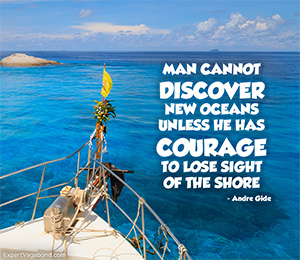 |
Answer to Que Es Eso?
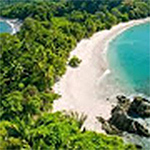
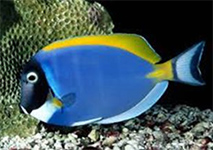 The minute I saw the picture of the beach I thought it's shape looked very much like the head of a tropical fish - note the eye, mouth and pelvic fins (those are the rocks shown in the beach picture at the bottom and to the right).
The minute I saw the picture of the beach I thought it's shape looked very much like the head of a tropical fish - note the eye, mouth and pelvic fins (those are the rocks shown in the beach picture at the bottom and to the right).
OK, no comments please about how much time GG has on his hands. I do know that, since cataract surgery, my vision has improved significantly and I can see colors a lot better than before (no yellow, pale or overcast haze anymore - well, a little bit in that left eye). Now about what I see in those clouds floating over the hill near my apartment...
Las Pintas
This is the term used to designate the first 12 days of the year which, according to legend, will forecast the weather in the rest of the year.
The most common translation of pinta or pinto is "spot". The famous Latin American and Costa Rican dish gallo pinto literally translates as spotted rooster. The nuance of the word is probably also the reason certain horses are called pintos. The word derives from pintar, to paint.
Contraloría
The primary translation is "Controller's Office". In many private and public Costa Rican institutions and businesses this is the office that usually corrects mistakes or tries to solve client problems.
Ronny's Place, Manuel Antonio
Location: From Quepos take the main road to Manuel Antonio until just past Hotel Gaia. Turn right on he unpaved road across from Amigos del Rio - it's on the left at the end of the road (about 1/2 mile).
Hours: Sunday to Saturday from 12:00 PM to 10:00 PM
Parking: Ample at the restaurant.
Contact: Tel.: 2777-5120; Email: info@ronnysplace.com; Website: http://www.ronnysplace.com/
Reviewing ROMEOS: Alma L., Bob N., Dean S., Glen N., Jerry C., Julia S., Kathleen K., Lorraine S. and Sari H.
To Review Our Rating System and Procedure, go here: R.O.M.E.O. Rating System
The ROMEOs last reviewed this restaurant in August of 2013 and that review can be seen HERE.
Actually not much has changed since our previous review more than four years ago. The only significant change is that they seem to have added a second name for the place. It's still known as Ronny's Place but has also acquired the moniker: "Mi Lugar (My Place)". One ROMEO suggested this might be to attract a larger Tico clientele but, whatever, the place can now be known as Ronny's Place or Mi Lugar (the staff that day were wearing "Mi Lugar" shirts..
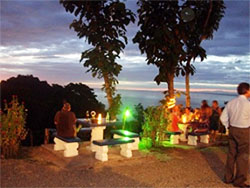 The restaurant still offers one of the best views of the Pacific and the sunset. The day we visited the sunset was gorgeous but the last 15 minutes of it was obscured by the hill that blocked our view and resulted from the angle of the sun in relation to the earth at this time of year. Come back in two months and the ball of fire will spectacularly drop into the patch of sea presented in front of us. We all gave thanks for no rain on that PM, something which has plagued us frequently in the early days of the dry season this year.
The restaurant still offers one of the best views of the Pacific and the sunset. The day we visited the sunset was gorgeous but the last 15 minutes of it was obscured by the hill that blocked our view and resulted from the angle of the sun in relation to the earth at this time of year. Come back in two months and the ball of fire will spectacularly drop into the patch of sea presented in front of us. We all gave thanks for no rain on that PM, something which has plagued us frequently in the early days of the dry season this year.
At the outdoor eating area we sat at a long table at the top edge of a valley that runs down to the Pacific. The tables and seats are done in tile surfaces and are attractive but GG could have used some padding for the cement seats. We gave Ronny's a composite score for ambiance of 4.4 sloths out of 5 possible.
The menu continues to offer a rather broad selection of fish, meat and pasta dishes plus a supplementary selection of specials. The extent of the variety is captured in the list of the entrees ordered by the ROMEO Group at this sitting: grouper (special); brochette of chicken; pork chop; whole red snapper; coconut shrimp, chicken pasta alfredo; shrimp salad; hamburger; chicken sandwich. There were a couple of beef fillets on the fare also.
GG started with a bruchetta consisting of the the rather standard chimichurri on broasted bread but which was also topped with a pesto-like herb relish that made the combination very tasty,
For a main course I took the chicken brochette which was substantial in the amount of chicken, peppers and onions that had been grilled. It was served with a melange of tender but not overcooked vegetables plus mashed potatoes. The vegetables were not inspiring nor very creative but they were tasty and filling.
All the ROMEOs reported satisfaction with the quality and quantity of their food and we gave Ronny's a composite score of 4.1 for food quality. |
 |
|---|---|
| $$$.4 | |
Value Index= 129 |
We were serviced initially by a young gent named Mauricio (standing in photo below) and by at least two others on the serving team. They were polite, helpful (when one ROMEO mentioned mosquitoes, a server appeared with some Off and another bug repellent) and friendly. The kitchen was somewhat slow considering the kind of food we ordered and the restaurant being half full when we ordered, but the main courses came to us all together, not always the practice in these parts. Composite score for service came in at 4.6 sloths yielding a combined score for ambiance, food quality and service of 4.4.
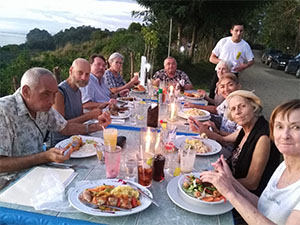 |
| ROMEOs Hard at Work at Ronny's |
For my meal, a natural drink consisting of a water-whip of pineapple and blackberry, one coke, the bruschetta and the brochette of chicken, the bill came to 11,562 colones (just about $20), a good price in these parts.
The composite score for cost came in at 3.4$ giving a value index of 4.4/3.4 x 100 = 129 which puts the restaurant in the top 1/3 of restaurants we've reviewed in our area for value.
The ROMEO group can easily recommend Ronny's Place, a.k.a. Mi Lugar, for a good meal at a fair price in an incredibly beautiful natural environment.
¡Pura Vida!
The Golden Gringo Chronicles is a free newsletter that is non-political, non-commercial and, hopefully, entertaining. By signing up you will receive an email each month around the first of the month giving you the links to the latest edition as well as to each individual feature and departmental section.
CLICK HERE TO SIGN-UP FOR THE
GOLDEN GRINGO CHRONICLES
or Email me at gg@goldengringo.com, and see our Website at: www.goldengringo.com

Bob Normand, Editor & The Golden Gringo
Pura Vida!
To Contact GGC World Headquarters (yuk, yuk) to make comments, suggest topics or criticize my bad jokes, just send an email to: gg@goldengringo.com.
Be pithy but kind; I'm sensitive. (center)
Unsubscribe from Golden Gringo Chronicles